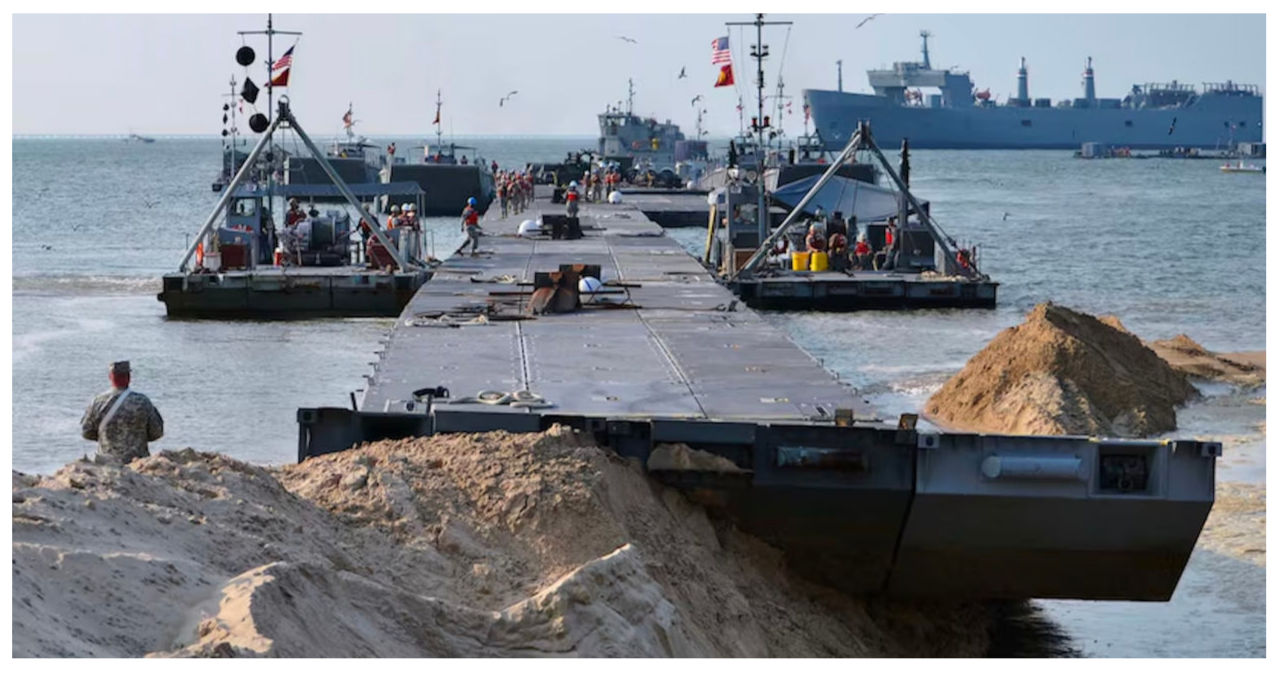The Pentagon announced on Thursday that the construction of the much-anticipated port and causeway off the coast of Gaza has commenced. This initiative by the U.S. military aims to establish a maritime corridor that will facilitate the delivery of essential humanitarian aid to Gaza.
“I can confirm that the construction of the initial stages of the temporary pier and causeway at sea has been initiated by U.S. military vessels, including the USNS Benavidez,” stated Maj. Gen. Pat Ryder, the Pentagon’s press secretary. He referred to the Joint Logistics Over-the-Shore, or JLOTS, system floating pier delivery system.”
He added that they are aware of the immense interest in this crucial endeavor and will soon provide more information as they collaborate with the global community to expedite assistance to the people of Gaza.
According to the Pentagon’s estimation, once it becomes operational, the pier would serve as a valuable addition to the existing land crossings for aid into Gaza. In addition, it has the potential to provide up to 2 million meals per day to the people of Gaza.
Satellite images captured by Planet Lab reveal ongoing construction in the designated land area where the causeway will be anchored, enabling aid-loaded trucks to enter Gaza with ease.
The USNS Roy Benavidez is currently active off the coast of Gaza, as seen on marine traffic websites. Its primary task is to construct a floating platform, which will serve as a means to offload supplies from civilian cargo ships. Furthermore, additional ships are on their way to Gaza from Crete, Greece. These ships were previously docked in Crete after completing a trans-Atlantic journey to the eastern Mediterranean.
According to a senior U.S. military official who provided a briefing on Thursday, the construction of the JLOTS landing platform commenced off the coast of Gaza.
According to an official, the delivery of humanitarian assistance to Gaza from the sea is set to begin in early May. The JLOTS pier, once operational, will have the capacity to handle approximately 90 trucks per day, with the potential to quickly increase to 150 trucks for the transportation of humanitarian aid.
According to the official, the increase in life-saving aid from the sea signifies a substantial boost in additional throughput.
Humanitarian assistance from aid agencies will undergo screening, palletization, and preparation for delivery in Cyprus, which is located 200 miles away from Gaza. The ultimate goal is for this aid to reach the JLOTS platform and floating causeway.
According to a senior U.S. military official, the aid will be unloaded at a floating platform located miles offshore. Subsequently, smaller watercraft will transport five trucks each, which will then be offloaded onto the floating causeway or pier anchored to the shore.
According to the official, the trucks will continually transport their cargo to a secure area for future distribution. This process will be repeated back and forth between the trucks and the floating platform.
According to an official, the truck drivers who will be responsible for the transportation will not be U.S. military personnel or American contractors. Instead, they will be individuals from an undisclosed country who are not Americans. These drivers will have their own security measures in place.
According to the official, the British naval ship Cardigan Bay will serve as the living and sleeping quarters for the hundreds of U.S. soldiers and sailors involved in the construction and operation of JLOTS. The ship will be stationed several miles offshore.
The Biden administration has consistently emphasized that there will be no American troops physically present in the region. However, this limitation does not extend to other personnel who will be assisting the JLOTS mission in Israel.
The floating platform in Gaza lacked U.S. forces to anchor it to the beach. To address this, a U.S. Army engineering unit collaborated with an IDF unit to provide training on anchoring the platform on the first day. The training took place on an Israeli beach nearby, as shared by a senior military official.
U.S. military personnel will work alongside Israeli Defense Forces personnel at a coordination cell located at Hatzor airbase in Ashdod, Israel. The cell is currently being managed by a three-star U.S. general.
The United States Agency for International Development (USAID) has set up a coordination cell in Cyprus to manage the logistics of delivering aid to Gaza via the maritime corridor.
Concerns about the security for the JLOTS mission, which U.S. officials have long acknowledged will be provided by the Israeli military, were raised on Thursday following a mortar attack near the location of the pier in Gaza City.
Ryder emphasized that this happened before any U.S. forces began relocating anything. He pointed out that there is no specific U.S. equipment in the marshaling yard, which will eventually be used to distribute aid offloaded via JLOTS.
According to a senior military official, the mortar attack has been determined to be unrelated to the JLOTS mission. The official also stated that security measures will be significantly strengthened once the location is operational.
“Our top priority is ensuring force protection,” emphasized the senior U.S. military official. He further elaborated that Israel has dedicated a brigade consisting of thousands of soldiers, along with Israeli Navy ships and aircraft providing aerial coverage. The purpose of this deployment is to safeguard American forces both offshore and at the landing and distribution centers on land.”
According to the official, the chosen location for the floating platform has been evaluated by the U.S. military, and it has been determined that the security there is adequate to support the mission. However, the final decision regarding this matter will ultimately rest with the commander of U.S. Central Command.



